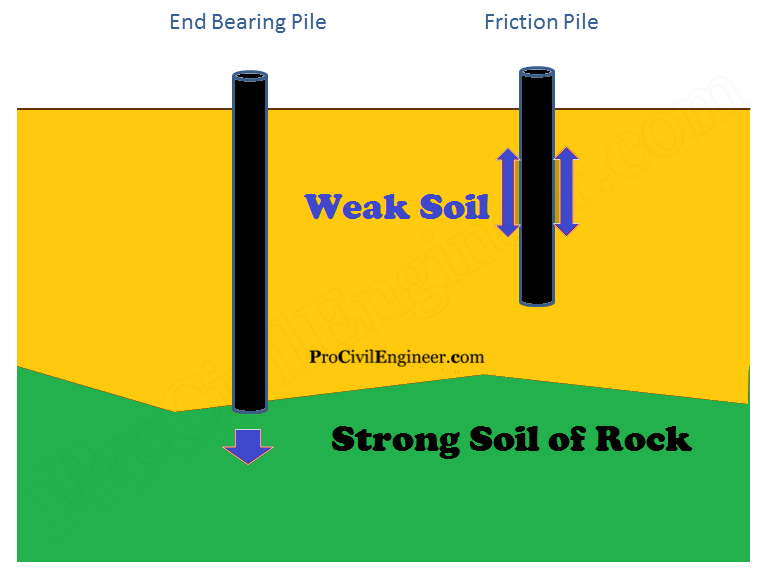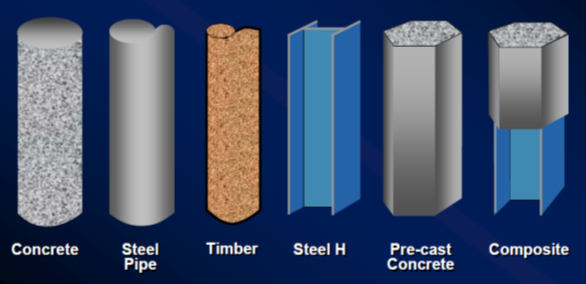A pile foundation is a type of foundation that is used to transfer the load of a structure to the ground through vertical elements, called piles, that are driven or cast into the ground. Pile foundations are used in situations where the soil is not strong enough to support the weight of the structure, or where the structure is being built on unstable or sloping ground.
There are several different types of pile foundations, including end-bearing piles, friction piles, sheet piles, screw piles, timber piles, and concrete piles. The type of pile foundation that is most suitable for a particular project will depend on the soil conditions, the load-bearing capacity of the soil, and the specific requirements of the structure being built.
Pile foundations are used in a variety of construction projects, including bridges, buildings, and offshore platforms. They are typically more expensive to install than other types of foundations, such as shallow foundations, but they are also more reliable and can support larger loads.
There are several different types of pile foundations that are used in construction, including:
- End-bearing piles: These piles are driven into the ground until they reach a solid layer of soil or rock, at which point they transfer the load of the structure directly to the ground.
- Friction piles: These piles are driven into the ground and rely on the friction between the soil and the surface of the pile to transfer the load of the structure to the ground.
- Sheet piles: These piles are made of interlocking sections of sheet material, such as steel or concrete, that are driven into the ground to create a wall-like foundation.
- Screw piles: These piles are made of a helical blade that is driven into the ground, similar to a screw. They are used to transfer the load of the structure to the ground through both end-bearing and friction.
- Timber piles: These piles are made of wood and are used to transfer the load of the structure to the ground through friction and end-bearing.
- Concrete piles: These piles are made of concrete and are used to transfer the load of the structure to the ground through end-bearing or friction.
The type of pile foundation that is most suitable for a particular project will depend on the soil conditions, the load-bearing capacity of the soil, and the specific requirements of the structure being built.
How to Define Pile Foundation?
A pile foundation is defined as a series of columns constructed or inserted into the ground to transmit loads to a lower level of subsoil. A pile is a long cylinder made up of a strong material, such as concrete. Piles are pushed into the ground to act as a steady support for structures built on top of them. Piles transfer the loads from structures to hard strata, rocks, or soil with high bearing capacity. The piles support the structure by remaining solidly placed in the soil. As pile foundations are set in the soil, they are more tolerant to erosion and scour.
Pile foundations are used in the following situations:
- When there is a layer of weak soil at the surface. This layer cannot support the weight of the building, so the loads of the building have to bypass this layer and be transferred to the layer of stronger soil or rock that is below the weak layer.
- When a building has very heavy, concentrated loads, such as in a high rise structure, bridge, or water tank.
Pile foundations are capable of taking higher loads than spread footings.
A pile foundation is a type of deep foundation that is used to transfer the load of a structure to the ground through vertical elements, called piles, that are driven or cast into the ground. Pile foundations are used in situations where the soil is not strong enough to support the weight of the structure, or where the structure is being built on unstable or sloping ground.
What are pile foundations used for? Pile foundations are principally used to transfer the loads from superstructures, through weak, compressible strata or water onto stronger, more compact, less compressible and stiffer soil or rock at depth, increasing the effective size of a foundation and resisting horizontal loads.
Types of Piles Foundation
Pile foundations can be classified based on function, materials and installation process, etc. Followings are the types of pile foundation used in construction:
Types of Piles : Classification Based on the Function
- End bearing Pile
- Friction Pile
- Compaction Pile
- tension Pile or Uplift Pile
- Anchor Pile
- Fender Pile or Dolphins
- Batter Pile
- Sheet Pile
Types of Piles : Based on Materials and Construction Method
- Timber Piles
- Concrete Piles
- Steel Piles
- Composite Piles
The following diagram is representing pile foundation types discussed above. There are two fundamental types of pile foundations (based on structural behaviour), each of which works in its own way.
End Bearing Piles
In end bearing piles, the bottom end of the pile rests on a layer of especially strong soil or rock. The load of the building is transferred through the pile onto the strong layer. In a sense, this pile acts like a column. The key principle is that the bottom end rests on the surface which is the intersection of a weak and strong layer. The load therefore bypasses the weak layer and is safely transferred to the strong layer.Friction Piles
Friction piles work on a different principle. The pile transfers the load of the building to the soil across the full height of the pile, by friction. In other words, the entire surface of the pile, which is cylindrical in shape, works to transfer the forces to the soil.
To visualize how this works, imagine you are pushing a solid metal rod of say 4 mm diameter into a tub of frozen ice cream. Once you have pushed it in, it is strong enough to support some load. The greater the embedment depth in the ice cream, the more load it can support. This is very similar to how a friction pile works. In a friction pile, the amount of load a pile can support is directly proportionate to its length.

WHAT ARE PILES MADE OF?
Piles can be made of wood, concrete, or steel.
In traditional construction, wooden piles were used to support buildings in areas with weak soil. Wood piles are still used to make jetties. For this one needs trees with exceptionally straight trunks. The pile length is limited to the length of a single tree, about 20m, since one cannot join together two tree trunks. The entire city of Venice in Italy is famous for being built on wooden piles over the sea water.

Concrete piles are precast, that is, made at ground level, and then driven into the ground by hammering – more on that later. Steel H-piles can also be driven into the ground. These can take very heavy loads, and save time during construction, as the pile casting process is eliminated. No protective coating is given to the steel, as during driving, this would be scraped away by the soil. In areas with corrosive soil, concrete piles should be used.
Question : Are pile foundations expensive?
Answer : A pile foundation is generally more expensive than an ordinary shallow foundation, and is used where soil at or near the surface is of poor bearing capacity or settlement problems are anticipated.
Question : Where is pile foundation used?
Answer : Pile foundations is type of deep foundation which are generally used in high rise building construction and bridge constructions. It is also used where the site has a weak shallow bearing strata making it necessary to transfer load to a deeper strata either by friction or end bearing principles.
Question : What are the advantages of pile foundation?
Answer : Main advantages of pile foundation are high load capacities and corrosion resistance. And there is a disadvantage of piles foundations also acids that can damage the concretes and may occur salt water reactions. If there is soil on it we cannot keep the building vaccinated on it, so the pile foundation is used.
Question : What is concrete piling?
Answer : A pile is basically a long cylinder of a strong material such as concrete that is pushed into the ground to act as a steady support for structures built on top of it. Pile foundations are used in the following situations: When there is a layer of weak soil at the surface.